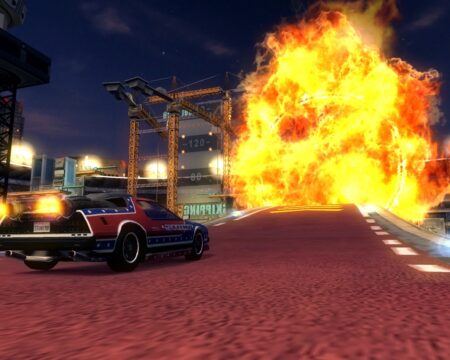
FlatOut 2
Written by: Rik
Date posted: October 28, 2013
- Genre: Racing
- Developed by: Bugbear
- Published by: Empire Interactive
- Year released: 2006
- Our score: 9
Remember how in The Dukes of Hazzard, the two good ol’ boys would evade the cops in virtually every single episode by attempting an improbable jump over something (usually a ravine)? You’d see the car mount a ramp, sail impressively through the air, and land with a bump, relayed via an in-car shot of the driver and passenger acknowledging mild discomfort, before continuing on with their journey. Yee-hah!
Eventually, though, someone, probably your Dad, would observe you enjoying such japes with wild-eyed innocence, and point out that in reality, a single jump of this nature would most likely buckle the suspension of the General Lee and cause major damage to the car. (See also: Knight Rider and Turbo Boost). FlatOut 2 is your Dad’s version of The Dukes of Hazzard, allowing you to attempt unlikely jumps and stunts, enjoy a brief rush of adrenaline as you soar like an eagle, before coming down to earth with a bang as your vehicle crashes, rolls and disintegrates.
The original FlatOut gave the impression of a game that wanted to push its madcap antics to the fore, but in reality it retained a lot of the same fundamentals as developer Bugbear’s previous racer, Rally Trophy, which had altogether more serious intentions. FlatOut 2, on the other hand, forces some serious hi-jinks upon you, and if I was the kind of person who used such phrases, I’d be throwing words like ‘on steroids’ or ‘turned up to 11’ around at this stage. (I’m not that kind of person, but evidently I’m also not the kind who can come up with anything wittier or cleverer either).
While in FlatOut, you could generally avoid the carnage, in FlatOut 2, the carnage finds you. There’s a lot more going on – the tracks are more detailed, there’s more debris, there are more shortcuts, there are more collisions, there are more accidents. You may have a plan to play it safe and follow the track rather than attempting a near-suicidal jump, but with all that’s going on, you’ll probably get distracted during one lap and find yourself doing the exact opposite. You might want to avoid smashing into your opponents, but they certainly won’t avoid smashing into you.
In other words, there’s no such thing as a quiet race. Yes, there are times when you’ll find yourself out in front, ahead of the pack. This is the most dangerous time of all. The temptation, of course, is to drive cautiously – but that’s not playing the game. It’s called FlatOut, so you’re meant to drive…well, you know. The moment you start fiddling around and playing it safe, you get punished – either through the actions of an opponent, or by simply messing up in one of the hundreds of ways you can manage do so on each track regardless of your caution.
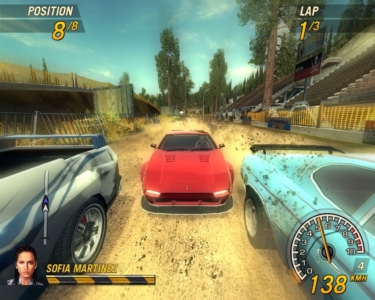
Using the reverse camera is likely to make you crash – you need to see where you’re going at all times.
It’s fair to say that FlatOut 2 uses an AI catchup system. But, unlike in, say, Need for Speed: Underground, where you breeze through a race in first place and then make one slip up and end up losing, it’s not deployed in a brazenly obvious manner. There’s so much going on, you won’t have time to notice anything that might seem slightly awry. It also helps to realise that this just isn’t the kind of game where you can do the perfect lap. You might mess up a corner and resolve to do better next time, and even actually do better next time, but there are so many other things that could have happened by that point that it won’t even matter. Consistency is rewarded, but not always with victory. As with its predecessor, FlatOut 2 is a game where you’ll occasionally have to settle for second or third place and view it as an achievement.
This is particularly the case in the career mode, which, as ever, is where you’ll spend most of your time. The overall structure remains largely unchanged from the original game. There are three distinct classes of car and race: ‘Derby’ (old bangers), ‘Race’ (cars vaguely resembling those in FlatOut), and ‘Street’ (flashy roadsters). Predictably enough, the first class of car is the slowest, easiest to handle and can take the most damage, and as you progress you’ll get to drive faster cars that are a bit more slippery and can’t take as much of the careless smashing into walls as you might previously have been used to.
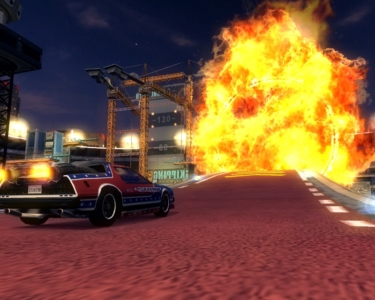
You get a choice of special vehicles for the ragdoll events. This particular event, as you can see, involves fire.
Each division class features a mixture of events: standard 3-5 lap races (in a variety of environments), destruction derbies, and ‘ragdoll sports’ (in which your hapless driver is catapulted through the windscreen and manipulated in some way or another). I personally felt that the ragdoll element was overused in the main game last time around, with even minor collisions sending your poor driver flying so (presumably) you could have a good old laugh about it. Thankfully it seems to have been toned down for the sequel, within the races at least, and now only a truly terrifying collision with an extremely solid object prompts the telltale wail of despair that accompanies your avatar’s exit.
Having said that, though, there are now more separate ragdoll events than before, and those who enjoy the thought of launching a pretend man through the windscreen of a car and into a giant basketball hoop will find plenty to entertain them here. I’ve heard it said that these slapstick side-dishes are in fact the best part of the FlatOut experience; not only do I disagree (and could happily do without them altogether) but think that this does a massive disservice to the core game.
The racing here is really, really good – taking everything that FlatOut did well and expanding upon it to great effect. The tracks are big and open, and remain free of the dreaded ‘invisible wall’ syndrome, and are (with one or two exceptions) extremely well-designed, with strategically-placed obstacles and debris, and different routes having a good risk/reward balance. As before, you can earn a nitro boost by driving dangerously – be that a big jump, smashing through scenery (shop or restaurant windows are always a good bet) or causing damage to your opponent, but this time you’re much more likely to keep it topped up just by driving well, such is the level of activity during any given race, rather than making a conscious decision to do something rash. As a result, nitro is more of a general by-product than before, acting as a consolation prize when you’ve just attempted a massively dangerous (but ultimately unsuccessful) jump and need a bit of catch-up.
The graphics and sound have also undergone a transformation. While FlatOut was perfectly fine in this regard, FlatOut 2 seemingly has its sights set on the AAA racing franchise market dominated by the likes of Need for Speed. The visuals have improved noticeably, exuding the requisite levels of blurry glossiness that seem to be required when playing with the big boys. Meanwhile, sparks, shards of broken glass and debris accompany every crash and smash, and there’s an impressive amount happening on-screen at any one time. On the sound front, songs by unsigned bands have been replaced by licensed pop hits, including recent chart smash Richard III by Supergrass [do you want to tell him, or shall I? – FFG reader]. The line-up features acts that used to be popular (Fall Out Boy), those that were never popular (Megadeth), some that I’ve never heard of (Yellowcard), and some that would feature in most people’s lists of ‘worst bands of all time’ (Papa Roach, Nickelback). Fortunately, I have a dreadful taste in music, although I have to say that the chosen genre seems particularly suited to the action – however much you might like noodley acoustic indie, it doesn’t belong with the kind of meatheaded, high-octane action on offer here.
Whatever your musical preferences, though, FlatOut 2 belongs in the top drawer of racing titles. It’s certainly pretty tough, and some might find that a turn-off, while others might point to the frequency with which the restart button needs to be used, and the occasional generosity of your respawn position as indicative of a fundamental flaw in the game hastily, and clumsily, balanced out. My own position, though, is that once you get it into your head that you won’t win every race, and it’s more about remaining in contention across a series of races, it’s actually not that hard to progress, while the restart button is a necessary part of any game that features this many crashes and accidents, acknowledging the mistake you’ve made but without leaving you stuck to scenery or wheelspinning in a field somewhere.
My main criticism would be that the structure of the career mode could be worked on. There doesn’t seem to be a massive difference between classes, for starters. You race on the same tracks in each class, with the idea being that it’ll be harder later on with faster, more slippery and less durable cars. I wonder if it might have been an idea to play to the strengths of each class a little more – keep the derby races on dirt tracks, and progress to tarmac and street races when you get to the more powerful cars.
The major problem, though, with the way FlatOut 2 is set up is that, although the thrills and spills last for a good while, there comes a point at which you wonder when you’re going to see something new. As with many modern racers, it falls into the trap of making you race on the same tracks over and over and over again, to little end, in order to drag things out. Plus, while it deserves credit for recognising that, in the mind of the player, a named avatar with a recognisable vehicle encountered again and again provides a much more effective nemesis than any actor-slash-model turning up in cut-scenes, talking smack, and then disappearing again (for more on which, see, Jack Benton must die), you do rather hope for a little more than a blurry video clip of a trophy as reward for ploughing through the career mode.
Complaints are a little churlish, though, when you consider that the core action provides all the thrills and spills you could want. Driving fast is supposed to be exciting yet fraught with danger, and FlatOut 2 provides that adrenaline rush, clouding the judgement of the player and inviting him or her to attempt the risky or impractical (see I live for this…stuff) for marginal reward. One of my favourite games of recent times, and as such, deserving of wholehearted recommendation.

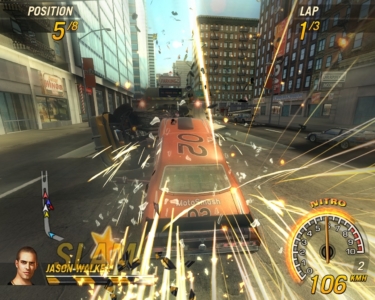
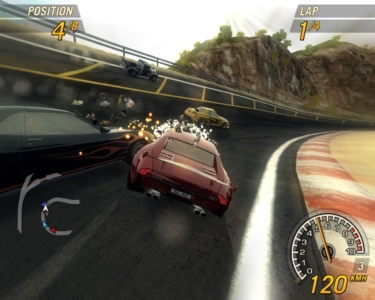
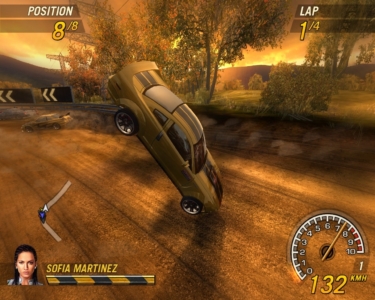

 Posts
Posts